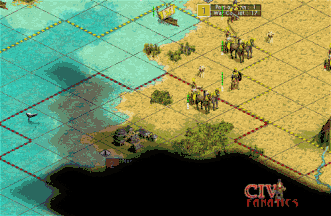 GOTM9 -
Capturing the Japanese Port of Nagoya
GOTM9 -
Capturing the Japanese Port of Nagoya
|
GOTM9 Index Items below this point
Known Bugs and Glitches |
The second full turn of the war with Japan, opens with a minor counterattack by a Japanese horseman at the southwestern front of the advance into Japanese territory. The attacking regular horseman was barely defeated by our veteran war chariot covering the stack of war chariots that was in range of the Japanese port city of Nagoya. Taking
Nagoya
Prioritizing
road connections This map layout demonstrates another excellent example of the impact of orthogonal grid movement distances on the choices we might make in building roads or advancing units. The road crew workers under the spearman stack centered between Toyama and Nagoya could be routed directly in a line to Nagoya or they could move one tile straight south and build the same equivalent road connection in the same amount of time. This southern route pushed the road crew closer to the attacking Japanese warrior, but it also would potentially shorten the distance to Kyoto by one turn’s worth of road building if that route became necessary. If you look carefully at the animated replay of the moves, you will see that I first completed the road link under the spearmen and then advanced enough road crew workers forward to guarantee completing the next link in the port road connection as a first priority in the next turn. The extra road crew worker was sent to begin the inland section of the link to Toyama. (Don’t worry; we did not leave the workers undefended.)
Landing reinforcements from the sea Fortunately, the orthogonal travel paths of the two galleys could cross in mid-turn and allow the suez galley to transfer its troops to the eastern galley for final transport on to Nagoya. This “Ferry Boating” skill is sometimes referred to as “ship hopping” in some discussion forums and it reflects a key transportation skill that can selectively increase the single turn reach of units that must use water borne transport. The galley delivered the full health swordsman and horseman into Nagoya by unloading the units from one tile out to sea, just is if this had been a coastal landing with no port city present. The landing move used up the movement abilities of both these units for the turn but raised the garrison strength in Nagoya to five units and more than tripled the defensive strength.
Other related topics:
|
 ©
2002 by cracker@CivFanatics.com
©
2002 by cracker@CivFanatics.com
All rights reserved. Please read the Terms
of Use.
Send mail to our webmaster with technical
questions about or potential problems with this web site.

